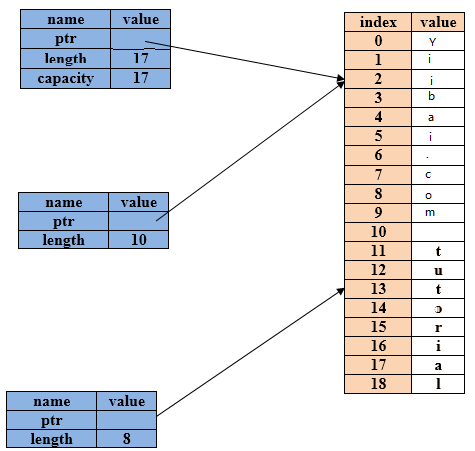切片(Slice)是一种没有所有权的数据类型。 切片引用连续的内存分配而不是整个集合。 它允许安全,高效地访问数组而无需复制。 切片不是直接创建的,而是从现有变量创建的。 切片由长度组成,并且可以是可变的或不可变的。 切片的行为与数组相同。
字符串切片
字符串切片指的是字符串的一部分。 切片看起来像:
let str=String::from("Yiibai.com tutorial");
let yiibai=&str[0..10];
let tutorial=&str[11,18];
如果想要取一部分字符串,而不是整个字符串。 [start..end]语法是一个从开始但不包括结束的范围。 因此,可以通过指定括号内的范围来创建切片,例如[start..end],其中start指定元素的起始位置,end比切片中的最后一个位置多一个。如果想要包含字符串的结尾,那么必须使用..=而不是..。
let str= String::from("yiibai.com tutorial");
let yiibai = &str[0..=9];
let tutorial= &str[11..=18] ;
图解表示:

如果要从0开始索引,那么也可以删除起始索引。看起来如下:
let str= String::from("hello world");
let hello = &str[0..5];
let hello=&str[..5];
如果slice包含字符串的最后一个字节,那么可以删除起始索引。看起来如下:
let str= String::from("hello world") ;
let hello=&str[6..len];
let world = &str[6..];
下面来看一个字符串切片的简单示例:
fn main(){
let str=String::from("Yiibai.com tutorial");
let yiibai=&str[..=9];
println!("first word of the given string is {}",yiibai);
}
执行上面示例代码,得到以下结果 -
first word of the given string is Yiibai.com
字符串切片是文字
字符串文字存储在二进制文件中,字符串文字仅作为字符串切片。 如下:
let str = "Hello Yiibai" ;
str的类型是&str,它是指向二进制文件特定点的切片。 字符串文字是不可变的,&str是不可变的引用。
字符串切片作为参数
如果有一个字符串切片,那么可以直接传递它作为参数。将字符串切片作为参数传递给函数,而不是传递引用,以使API更通用和有用,而不会失去其功能。
fn main()
{
let str= String:: from("Computer Science");
let first_word= first_word(&str[..]); //first_word function finds the first word of the string.
let s="Computer Science" ; //string literal
let first_word=first_word(&s[..]); // first_word function finds the first word of the string.
let first_word=first_word(s) ; //string slice is same as string literal. Therefore, it can also be written in this way also.
}
其他切片
数组也可以视为切片。它们的行为类似于字符串切片。 切片的类型为[&i32]。 它们通过将引用存储为第一个元素并将长度存储为第二个元素,类似于字符串切片。
考虑下面一个数组:
let arr = [100,200,300,400,500]; // array initialization
let a = &arr[1..=3]; // retrieving second,third and fourth element
下面来看一个简单的例子。
fn main()
let arr = [100,200,300,400,500,600];
let mut i=0;
let a=&arr[1..=3];
let len=a.len();
println!("Elements of 'a' array:");
while i<len
{
println!("{}",a[i]);
i=i+1;
}
}
执行上面示例代码,得到以下结果 -
Elements of 'a' array:
200
300
400





